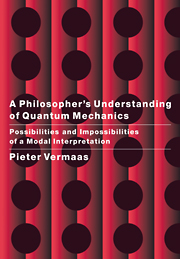
-
Select format
-
- Publisher:
- Cambridge University Press
- Publication date:
- 28 October 2009
- 28 January 2000
- ISBN:
- 9780511608230
- 9780521651080
- 9780521675673
- Dimensions:
- (247 x 174 mm)
- Weight & Pages:
- 0.69kg, 308 Pages
- Dimensions:
- (247 x 174 mm)
- Weight & Pages:
- 0.783kg, 308 Pages
You may already have access via personal or institutional login
Book description
This book is about how to understand quantum mechanics by means of a modal interpretation. Modal interpretations provide a general framework within which quantum mechanics can be considered as a theory that describes reality in terms of physical systems possessing definite properties. Quantum mechanics is standardly understood to be a theory about probabilities with which measurements have outcomes. Modal interpretations are relatively new attempts to present quantum mechanics as a theory which, like other physical theories, describes an observer-independent reality. In this book, Pieter Vermaas summarises the results of this work. The book will be of great value to undergraduates, graduate students and researchers in philosophy of science, and physics departments with an interest in learning about modal interpretations of quantum mechanics.
Reviews
‘… the strengths of this book are its clear, detailed exposition of the quantum formalism, and the way in which issues of interpretation are related back to this formalism … the book is very mathematical.’
Rachel Wallace Garden Source: Zentralblatt für Mathematik
Contents
Metrics
Full text views
Full text views help Loading metrics...
Loading metrics...
* Views captured on Cambridge Core between #date#. This data will be updated every 24 hours.
Usage data cannot currently be displayed.
Accessibility standard: Unknown
Why this information is here
This section outlines the accessibility features of this content - including support for screen readers, full keyboard navigation and high-contrast display options. This may not be relevant for you.
Accessibility Information
Accessibility compliance for the PDF of this book is currently unknown and may be updated in the future.


